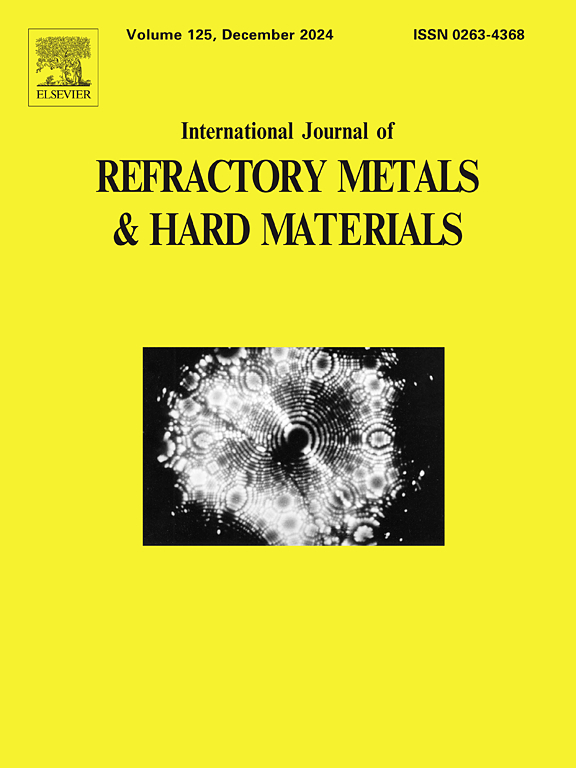Effect of annealing temperature on the microstructure and mechanical properties of Al15Ti35V20Nb15Zr15 alloy
IF 4.2
2区 材料科学
Q2 MATERIALS SCIENCE, MULTIDISCIPLINARY
International Journal of Refractory Metals & Hard Materials
Pub Date : 2025-03-14
DOI:10.1016/j.ijrmhm.2025.107154
引用次数: 0
Abstract
In this study, the effects of annealing temperature on the microstructure and mechanical properties of Al15Ti35V20Nb15Zr15 lightweight high-entropy alloy were systematically investigated. Results indicate that the Al15Ti35V20Nb15Zr15 alloy exhibits a dual-phase structure consisting of body-centered cubic (BCC) and hexagonal close-packed (HCP) phases. As the annealing temperature increases, the HCP phase grows along the grain boundaries, accompanied with the precipitation of a needle-like phase. The alloy primarily demonstrates a dendritic structure, and the rise in annealing temperature promotes dendrite refinement, reducing the grain size from approximately 227.21 μm to 88.28 μm. This refinement remarkably enhances the alloy's strength, hardness, and wear resistance. The yield strength of the alloy increases from ∼1718 MPa to ∼1941 MPa with the increase of annealing temperature. However, this enhancement partially affects plasticity primarily because of the precipitation of acicular phases, which hinders dislocation motion and the increase in internal stress within the alloy, thereby leading to reduced ductility.
退火温度对Al15Ti35V20Nb15Zr15合金组织和力学性能的影响
本研究系统研究了退火温度对Al15Ti35V20Nb15Zr15轻量化高熵合金组织和力学性能的影响。结果表明:Al15Ti35V20Nb15Zr15合金呈体心立方相(BCC)和六方密排相(HCP)双相结构;随着退火温度的升高,HCP相沿晶界生长,并伴有针状相的析出。合金主要表现为枝晶组织,退火温度的升高促进了枝晶细化,晶粒尺寸从227.21 μm减小到88.28 μm。这种细化显著提高了合金的强度、硬度和耐磨性。随着退火温度的升高,合金的屈服强度从~ 1718 MPa增加到~ 1941 MPa。然而,这种增强会部分影响塑性,主要是由于针状相的析出,这阻碍了位错运动和合金内部应力的增加,从而导致塑性降低。
本文章由计算机程序翻译,如有差异,请以英文原文为准。
求助全文
约1分钟内获得全文
求助全文
来源期刊
CiteScore
7.00
自引率
13.90%
发文量
236
审稿时长
35 days
期刊介绍:
The International Journal of Refractory Metals and Hard Materials (IJRMHM) publishes original research articles concerned with all aspects of refractory metals and hard materials. Refractory metals are defined as metals with melting points higher than 1800 °C. These are tungsten, molybdenum, chromium, tantalum, niobium, hafnium, and rhenium, as well as many compounds and alloys based thereupon. Hard materials that are included in the scope of this journal are defined as materials with hardness values higher than 1000 kg/mm2, primarily intended for applications as manufacturing tools or wear resistant components in mechanical systems. Thus they encompass carbides, nitrides and borides of metals, and related compounds. A special focus of this journal is put on the family of hardmetals, which is also known as cemented tungsten carbide, and cermets which are based on titanium carbide and carbonitrides with or without a metal binder. Ceramics and superhard materials including diamond and cubic boron nitride may also be accepted provided the subject material is presented as hard materials as defined above.

 求助内容:
求助内容: 应助结果提醒方式:
应助结果提醒方式:


